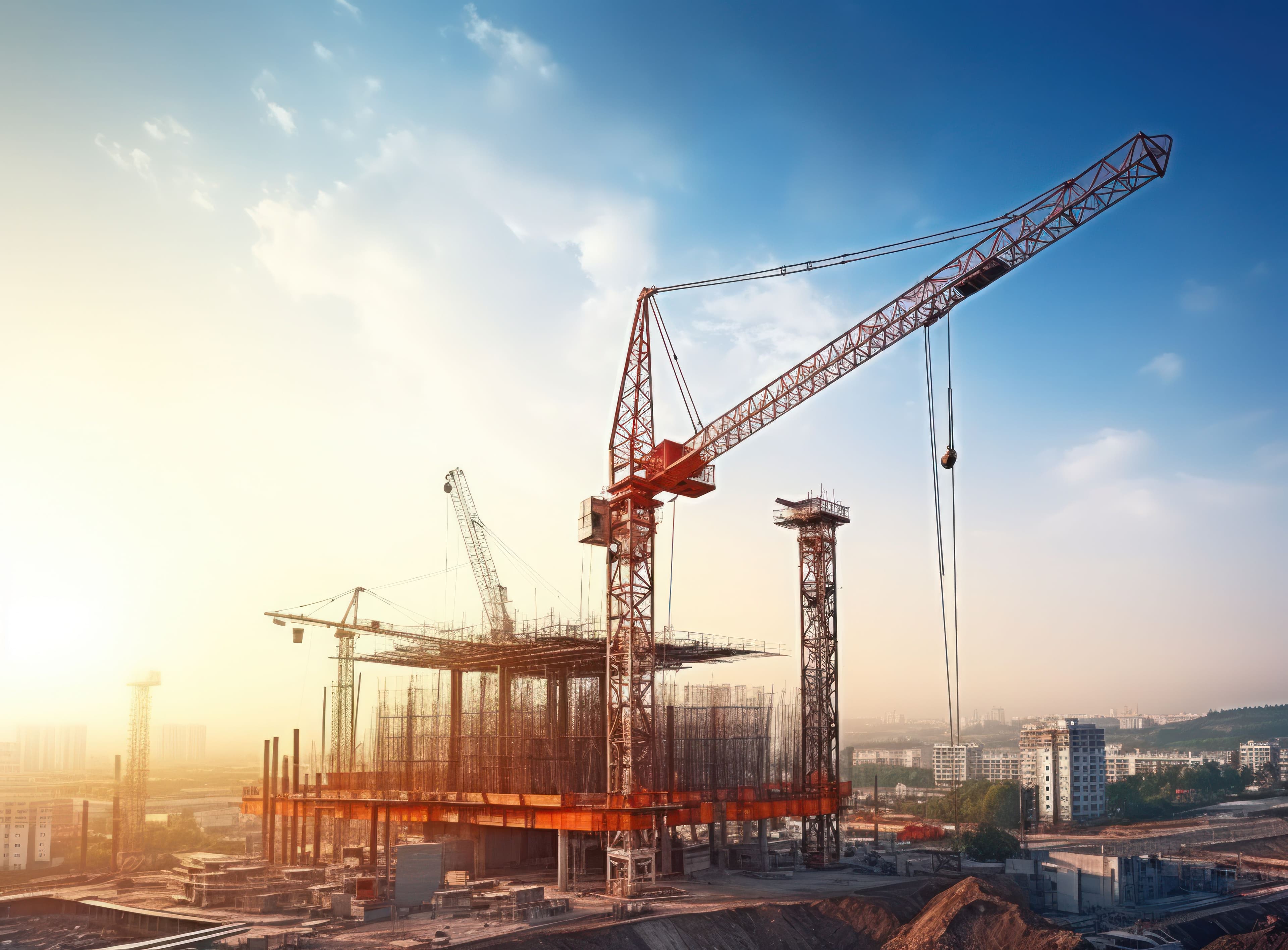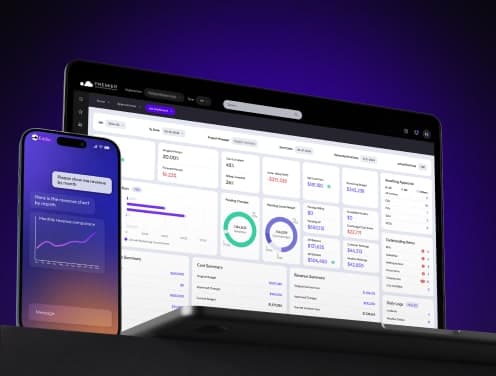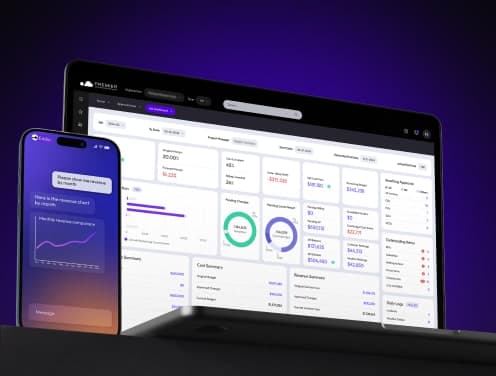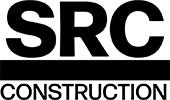
What is Generative AI in Construction and Why It’s a Game Changer
Generative AI is changing everything about construction. It brings unprecedented precision, efficiency, and sustainability to the industry. AI can now automate up to 49% of construction tasks, which fundamentally changes how teams design, plan, and build structures.
The numbers tell an impressive story about generative AI's role in construction. Market projections show the global generative AI construction market reaching $404.63 million by 2026. This figure will surge to $6,074.81 million by 2034, showing a CAGR of 35.12%. These figures highlight how much value AI brings to the sector.
Construction professionals find generative AI appealing for good reasons. It creates multiple design options in seconds, pushing the boundaries of what's possible. Industry leaders are taking notice - 78% say AI will boost their industry. About 66% believe AI will become crucial in every aspect within two to three years.
Gen AI's benefits touch every part of the project lifecycle. Companies use it to boost productivity (44%), create better-informed design options (36%), and spot performance gaps in products and assets (34%). The AI construction market will grow from $4.86 billion in 2025 to $22.68 billion by 2032. Understanding these tools' benefits for your operations becomes crucial.
This piece explains what generative AI means for construction professionals. You'll learn about its real-life applications in current projects and steps to prepare your business for this technological advancement. The guide covers practical uses in design, construction, and post-construction phases, plus ways to tackle common implementation challenges.
How Generative AI is Being Used in Real Construction Projects
Construction projects now make use of generative AI in all phases. Design conceptualization and structural optimization tools have proven their value in ground applications.
AiCorb for facade design and 3D modeling
Obayashi Corporation and SRI International created AiCorb, an AI technology that turns hand-sketched drawings and 3D models into multiple facade design options. This tool solves the biggest problem in architectural design: architects spend too much time developing concepts and creating sketches and CAD drawings for client approval.
AiCorb uses two AI models that work together. The first AI creates many facade design proposals from sketches and 3D model outlines. The second AI transforms these designs into 3D models on the Hypar platform. The results show that architects can reduce their work time on mid-sized building feasibility studies from eight weeks to less than one week.
AiCorb's value comes from its ability to make shared client work easier. Architects can quickly show client ideas and build consensus more effectively. The system goes beyond exterior designs. Researchers are learning about its use for interior layouts, which could help buildings with specific needs like hospitals.
SYMPREST for structural framing optimization
Shimizu Corporation's SYMPREST helps engineers plan structures for steel buildings. The system handles framework calculations and member sections automatically, which saves engineers substantial time on manual calculations.
SYMPREST helps with early-stage structural analysis and makes workflows more effective. Engineers can improve their designs without getting stuck on calculations. The tool fits well with existing processes, which lets structural teams focus on creative and complex work.
SYMPREST has its limits. The tool works with steel structures only, and poor input data leads to unreliable recommendations. This shows a common challenge with AI tools in construction, they need quality data to give valuable results.
BIM integration with generative design tools
Building Information Modeling (BIM) and generative design create a powerful system to optimize construction. This combination makes collision detection, material calculations, and maintenance planning easier throughout the project.
Project teams use this system to analyze conflicts between different construction disciplines. Research by Sampaio showed that BIM-based conflict analysis with 4D simulation models improves project coordination substantially. This leads to better scheduling and fewer construction errors.
BIM shows its strength in modular construction. Researchers developed BIM-based graph data models that help design modular buildings. These algorithms make spatial organization better by looking at functional relationships. This improves flow between building modules and interior space use.
Teams typically integrate these tools through specialized platforms:
- Autodesk Revit with Dynamo enables parametric scripting and algorithmic workflows
- Grasshopper with Rhino allows designers to create adaptive geometries
- Rosetta makes shared generative workflows possible
BIM-based frameworks can optimize steel reinforcement in concrete structures automatically. A research project combined a genetic algorithm with the Hooke-Jeeves search method. This reduced material use and sped up design processes.
The benefits are clear, but standard frameworks that fully integrate generative tools with BIM workflows continue to evolve. Premier Construction Software notes that companies need reliable data infrastructure to get the most from these technologies.
Generative AI in the Design and Planning Phase
Design and planning form the foundations of every construction project. Architects and engineers now have powerful AI tools that help them explore countless design possibilities and save time and resources.
Conceptual design generation from sketches and constraints
AI-powered tools now help architects turn simple sketches into detailed designs. Sketch2Prototype converts hand-drawn sketches into various 2D images and 3D prototypes through sketch-to-text, text-to-image, and 3D stages. This quick generation across different formats helps designers explore ideas early.
Obayashi Corporation's AiCorb creates multiple building facade designs from hand-drawn sketches and text descriptions. Designers can review proposed facade designs after volume studies and add them to 3D models. The company trained its AI to understand design intent from both detailed and rough sketches, offering different AI models based on the designer's needs.
AI goes beyond facades to create entire floorplans from sketches. One workflow creates conceptual floorplans and 3D models from simple sketches quickly. Designers can control architectural renderings through text descriptions. The process picks up key architectural design terms, building types, styles, features, materials, and views, to guide creation.
Engineering teams use generative design AI to make better designs within given limits. Systems like Autodesk Fusion let professionals explore many design options that meet requirements while looking at material use, structural strength, cost, and performance.
Site layout optimization using AI simulations
AI makes site layouts better through data analysis. Architects and planners create and test multiple program scenarios for owners. They use rule-based methods to turn program ideas into 3D designs.
Autodesk's Toronto MaRS office shows this in action. The team used AI to design a 60,000-square-foot workspace that matched employee's needs. After analyzing data about collaboration needs, distraction levels, and natural light, the AI created thousands of possible layouts. The final design balanced individual focus and team interaction.
Daisy built an automated system to optimize timber floor layouts, while Autodesk Research created Kratos for structural engineering design. These tools work together to provide a complete generative design system for timber structures.
Automated BIM model creation from 2D inputs
Turning 2D drawings into Building Information Models (BIM) used to take forever. AI now makes this process automatic. Several tools help convert 2D to 3D for BIM:
- WiseBIM (operating since 2017)
- Plans2BIM
- usBIM.planAI by ACCA
- BIMify
These tools use AI to turn 2D images into Revit and IFC objects. Users import plans, set the scale, let AI detect specific elements (walls, openings, slabs, etc.), then review and edit the generated model.
BIMify works like a factory, using machine learning to process files in batches. Users feed in floor plans and get back a complete Revit model using their own part families. The system turns six floor plan drawings into an editable RVT model in minutes.
Research shows that semi-automated BIM methods cut modeling time for all work types. The system creates object-oriented BIM models by recognizing drawings and extracting line-text data. The process starts by pulling knowledge from 2D drawings, separating lines and text. Lines show geometric patterns while text identifies materials, element types, and locations.
Construction companies using Premier’s construction accounting software need fewer resources to create and maintain models. They can still add complex geometry later. Companies save money by reducing manual work and supporting more field studies of facility management BIM in older buildings.
Generative AI in the Construction Phase
AI changes how construction works after design completion. Building professionals now see that AI's benefits go way beyond the drawing board and into daily site operations.
AI-driven resource allocation and labor planning
Building companies don't deal very well with optimizing their workforce, equipment, and materials. AI helps solve these issues by analyzing real-time data to distribute resources better. This approach guides projects toward less waste and lower costs.
AI systems review workforce skills, availability, and project details to assign tasks better. The right people work on the right tasks at the right time, which boosts productivity. Deloitte reports show that predictive maintenance reduces breakdowns by 70% and boosts productivity by 25%.
Project managers and superintendents get practical insights about:
- Resource utilization rates
- Productivity levels across different tasks
- Potential bottlenecks before they disrupt workflows
AI excels at finding the right number of workers needed for tasks. It accounts for skill levels, project timelines, and labor costs. A construction firm that used HVI's AI Agent reported cutting downtime by 50% in just one year. This saved thousands on emergency repairs.
AI also makes equipment management better through predictive maintenance. It spots potential problems early by analyzing sensor data, performance metrics, and past records. Teams can plan maintenance at the best times, which prevents delays that throw projects off schedule.
Real-time safety monitoring using sensor data
Computer vision and other AI tools watch construction sites constantly. They spot safety hazards, which improves site safety and reduces accidents. These systems use advanced algorithms to check visual data and warn managers about dangers.
Modern sensor technology and Internet of Things (IoT) help track many construction activities automatically. Systems from different groups (contractors, suppliers, logistics providers) blend through tablets and smartphone apps. This helps bridge the skills gap through technology.
AI-powered monitoring helps keep projects on time through constant oversight. Project teams can find and reduce risks as they appear. To name just one example, AI-powered sensors and cameras watch site activities non-stop. They quickly spot problems and check safety standards.
The main goal is to catch problems before they become serious. Sensors placed at key points collect data that gets processed right away. This gives teams practical insights to prevent disasters.
Dynamic project scheduling with GenAI tools
AI algorithms make project schedules better by checking resource availability, weather conditions, and risks. This creates realistic timelines with fewer delays. Machine learning models use past data to spot bottlenecks. Teams can then plan ahead to keep work flowing smoothly.
Note that AI can analyze thousands of scheduling scenarios. Traditional Gantt charts can't handle construction's unpredictable nature well. AI adapts better by including factors like:
- Task durations and dependencies
- Resource availability (equipment, labor, specialized skills)
- Material delivery lead times
- Real-time weather forecasts
- Regulatory compliance requirements
AI shows its real value by quickly shifting resources when unexpected events happen. It suggests the best ways to keep projects moving with minimal disruption.
Premier Construction Software offers tools that track AI's return on investment. Companies can measure how much their scheduling accuracy and resource allocation improve. Their software creates a base for AI adoption by putting all the training data in one place.
AI learns and improves over time. This helps construction teams make their resource planning better, which leads to more successful future projects.
Post-Construction Applications of Generative AI
A building's value extends way beyond the reach and influence of its construction phase. Generative AI revolutionizes how buildings operate, adapt, and perform throughout their useful life, well after the ribbon-cutting ceremony.
Predictive maintenance using sensor and usage data
Reactive maintenance belongs to the past. Generative AI and IoT sensors now help facility managers fix potential issues before they disrupt operations. This approach can reduce equipment downtime by up to 30% and lower maintenance costs by 20%.
IoT sensors throughout buildings track critical parameters:
- Vibration analysis for rotating machinery
- Ultrasound analysis to detect emerging issues
- Infrared analysis to identify temperature anomalies
AI algorithms analyze this data in centralized systems to spot patterns that signal potential failures. A mixer's increased vibration a week before bearings need lubrication triggers the AI to schedule maintenance automatically. This reduces unplanned downtime by 70% and increases efficiency by 25%.
Construction companies can copy, apply, and extend predictive maintenance by:
- Reviewing critical equipment and existing practices
- Installing appropriate sensors and IoT devices
- Establishing continuous monitoring protocols
Equipment owners who switch to AI-driven maintenance see fewer emergency repairs and longer asset lifespans. One construction firm cut downtime in half within a year using this approach.
Space planning and interior layout optimization
Space requirements change over time after construction. Generative AI excels at creating optimal interior layouts based on traffic flow, furniture placement, and lighting conditions.
AI-powered tools now help with post-construction space planning:
Eptura's Space Planning Software delivers real-time utilization data, strategic planning through digital twins, and interactive floorplan management. Hypar speeds up space planning and lets users review design viability with real-time performance visualization.
Skema's machine learning automates spatial planning for projects of all types. The cloud platform creates optimal spaces by analyzing functional relationships and usage patterns. Foyr offers a detailed platform that creates 3D floor plans to improve efficiency and comfort in residential and commercial buildings.
Energy performance tuning through AI feedback loops
Buildings use about 38% of global energy, with HVAC systems consuming much of this power. Generative AI tackles this challenge through smart Building Energy Management Systems (BEMS).
AI-based BEMS offer real-time monitoring, predictive analytics, and automated control adjustments that improve energy efficiency continuously. Advanced systems like EI-Build, an Explainable Artificial Intelligence (XAI) framework, make energy optimization models easier to understand.
Human-in-the-Loop systems represent a promising new direction. These systems learn from user feedback to balance energy efficiency with comfort instead of using fixed settings. Buildings become more attuned to human priorities and energy conservation goals through this feedback loop.
Data-driven energy quantification methods work well, but they need to be explainable for widespread adoption. Research with 137 participants showed that carefully chosen XAI methods can improve explanation satisfaction by up to 10%. This makes AI-driven energy decisions clearer to stakeholders.
Premier Construction Software's management platform creates the data infrastructure needed to make use of these post-construction applications. Their system helps track ROI while maintaining high-quality data for AI training.
How to Prepare Your Construction Business for GenAI
Companies need solid groundwork to adopt generative AI. Success with these advanced technologies doesn't happen randomly - you need proper planning and infrastructure. Companies that have made GenAI work point to three vital steps that shape the whole experience.
Digitizing workflows with cloud-based platforms
Cloud-based platforms create the digital foundation you need for AI to work. These solutions let teams cooperate across project sites in real time. Your documentation becomes available instantly and data silos disappear, these basics help AI succeed.
Cloud-based construction platforms give you several clear benefits:
- Centralized workspaces: Teams work better with secure, available storage for all project documentation
- Immediate updates: Stakeholders get instant messages, reducing miscommunication by 15%
- Mobile accessibility: Field teams update and access project data on-site. This improves operational efficiency by 35%
Your cloud solutions should work with your preferred browsers and devices. The software needs offline capabilities to save work during connection problems. A construction firm that adopted cloud services said, "Using software means it doesn't matter if you stop or get interrupted, your work is saved up to the point you left off".
Your apps should connect smoothly. Solutions that work together create a continuous flow of data between different platforms. Good integration helps architects, engineers, and contractors work together better. Their project information syncs automatically.
Building a centralized data repository for AI training
GenAI's success depends on one key element: high-quality data. Even the most sophisticated AI tools will fall short without well-organized information. A centralized data repository becomes your second vital step.
A Common Data Environment (CDE) solves this challenge. This centralized hub stores information in the cloud for all teams to access. A well-laid-out CDE:
- Acts as a single "source of truth" for all project information
- Makes data storage and formatting consistent
- Creates uniform protocols for data management
- Ensures quality control and consistency
Your data repository needs either ETL (Extract, Transform, Load) or ELT (Extract, Load, Transform) strategies. Most organizations choose ELT because it's flexible and fast. Raw data goes straight to the database for later processing.
BigQuery, Amazon Redshift, Azure Synapse Analytics, or Snowflake can store your construction data. You can link various data sources through Zapier, Fivetran, or custom serverless functions.
Construction companies that switched from scattered spreadsheets to standard data collection saw AI applications work much better. This standardization gave immediate insights through AI and machine learning. It led to smarter decisions.
Assessing current software for AI compatibility
Your existing technology stack needs a GenAI readiness check. Start with a digital readiness assessment that covers:
- Existing technology review: Find outdated tools and systems that don't connect well
- Infrastructure evaluation: Check if your hardware, network, and cloud capabilities support AI tools
- Technical knowledge gaps: Spot where employees lack training or don't understand AI's benefits
Construction AI software should work with your current systems like project management tools, BIM software, and ERP systems. Each platform should handle predictive analytics well. This includes forecasting project timelines, budget overruns, and potential risks.
Security remains vital. AI solutions must meet your organization's cybersecurity standards. They need strong data encryption to protect sensitive project information. Premier Construction Software offers secure cloud-based solutions that build the foundation for effective AI implementation while protecting data integrity.
Adopting generative AI in phases helps build internal expertise. You can see real results and reduce risks before full deployment. Small pilot projects focused on specific challenges work better than trying to change everything at once.
Cost and ROI Considerations for GenAI Adoption
Generative AI adoption in construction needs thorough financial planning that goes beyond technology. Companies must weigh immediate expenses against future benefits to make sense of their investment.
Upfront investment vs long-term savings
The original cost of implementing generative AI changes substantially based on project scale. Small AI deployments cost around $70,000, while larger implementations can exceed $750,000. These expenses include:
- Hardware and powerful computing infrastructure
- Software licenses and platforms
- System integration and custom development
- Employee training programs
- Data collection, cleaning, and preparation
These upfront investments deliver substantial returns. AI can automate about 45% of current construction tasks and contribute to $2 trillion in global wage savings. A $50 million office development typically faces 20% delays, but AI implementation can reduce extra costs from $2 million to $960,000.
How Premier Construction Software supports GenAI ROI tracking
Premier Construction Software's integrated platform creates strong foundations needed for GenAI implementation. Their AI-powered automation reduces manual data entry and maintains accuracy throughout the project lifecycle.
The system's built-in predictive intelligence helps teams spot budget variances, cost overruns, and performance gaps before they become major issues. This proactive approach gives construction companies clear visibility into their AI investment returns.
Premier's AI assistant, Eddie, watches project data and identifies potential red flags in financial, operational, and compliance areas. Users say Premier's automation solutions save at least 80% of the time they once needed to process invoices, showing clear ROI.
Reducing rework and change orders with AI insights
Rework remains a systemic problem in construction that increases costs and delays projects. AI tackles this challenge by finding discrepancies between design intent in Building Information Models and ground reality.
The construction AI market will grow at a compound annual rate of 20% by 2032. Companies tap into this technology to minimize expensive corrections through:
- Automated 360-photo analysis for accurate progress tracking
- Pattern recognition to identify design discrepancies
- IoT sensors to monitor material location and equipment utilization
- Virtual replicas to simulate physical asset behavior before implementation
Construction firms that use AI-driven safety tools cut workplace accidents by up to 25%, which leads to fewer injuries and lower insurance costs. AI-powered predictive maintenance reduces equipment downtime by about 70% and boosts productivity by 25%.
Overcoming Common Barriers to GenAI Implementation
Construction companies face several hurdles in implementing generative AI, despite growing interest. Companies must tackle these barriers with strategic solutions instead of avoiding them.
Addressing skill gaps through training programs
The rapid adoption of AI has created a major skills gap in construction. Only 1 in 10 global workers have the AI skills that organizations just need. This shortage prevents companies from using tools like machine learning, natural language processing, and data analysis effectively.
Companies should take these steps to close the gap:
- Offer workshops, certifications, and well-laid-out training programs
- Promote a culture of continuous learning
- Use no-code AI tools that work for all skill levels
One construction firm pointed out that upskilling isn't optional anymore. Workers who learn to operate AI systems become highly sought after. Companies can tailor their training through AI-powered platforms that assess each person's learning style and deliver custom content.
Ensuring data privacy and regulatory compliance
Construction companies must check how their AI applications store, process, and share information. Teams spend 30-50% of their innovation time making solutions compliant, a crucial investment that deserves attention.
Success with regulations requires specific AI governance strategies and clear usage guidelines. Companies should document how they've applied AI principles throughout development to answer potential questions from regulators. Premier Construction Software helps this process with built-in compliance features that protect data integrity while maximizing AI benefits.
Lining up AI tools with existing ERP systems
Technical challenges emerge when connecting AI with existing construction ERP systems. Legacy systems often don't play well with new AI tools, which leads to complex customizations. The right integration creates powerful capabilities for construction operations.
A secure self-service portal solves this by offering one access point to all confirmed AI capabilities. These platforms should have simple point-and-click processes and organized documentation libraries. It also needs automated governance guardrails to review code for responsible AI use. This prevents data policy violations and confirms AI outputs meet compliance standards.
Premier Construction Software builds the foundation for smooth AI-ERP integration. Its cloud-based approach lets construction companies add AI tools gradually without disrupting their current workflows.
Trends Shaping the Future of GenAI in Construction
Generative AI will change building lifecycles completely, going beyond individual project phases as the construction industry moves forward. New technologies show us what an integrated and efficient future looks like.
AI-powered digital twins for lifecycle management
Digital twins create virtual copies of physical structures that mirror every detail through 3D models and data. This technology helps optimize planning and enables paperless construction with clash detection. IoT sensors and drones capture up-to-the-minute progress to update the digital twin during construction. These models become valuable digital records that help manage facilities, predict equipment failures, and optimize energy use after completion. Building owners use these systems to track their HVAC, lighting, and security systems' performance. They also employ predictive analytics to plan maintenance ahead of time.
Generative AI in modular and offsite construction
AI algorithms now make prefabrication better by analyzing operation sequences, factory space, and equipment usage. Machine learning helps robots handle various tasks - from fastening screws to picking the right tools based on materials. These systems adapt to each project and spot bottlenecks more accurately. Computer vision automates quality control, which makes inspection faster and more precise.
AI-enhanced collaboration across stakeholders
AI tools also improve communication between project teams. When combined with Building Information Modeling, large language models automate documentation, improve communication, and help with compliance checks. Premier Construction Software supports this shift by offering platforms that are the foundations of AI-powered collaboration.
Conclusion
Generative AI's integration throughout the construction lifecycle represents a revolutionary force in the industry. This piece shows how AI revolutionizes everything from original sketches to post-construction maintenance. The market value speaks for itself - from $404.63 million in 2025 to over $6 billion by 2034, showing the enormous value these technologies deliver to construction professionals.
AI affects every project phase deeply. Tools like AiCorb and automated BIM creation reduce weeks of work to just days during the design phase. Construction teams benefit from AI-driven resource allocation and live safety monitoring that cuts accidents by up to 25%. Predictive maintenance systems slash equipment downtime by about 70% after completion while making energy use more efficient.
Your business needs strategic planning to adapt to this technological transformation. Start by moving processes to cloud-based platforms that enable live collaboration. Next, create a centralized data repository as your "single source of truth." Before implementation, check your existing software stack for AI compatibility.
Small deployments cost around $70,000 while larger implementations reach $750,000. These investments often pay off as AI can automate nearly half of construction tasks. Large projects can save millions by reducing delays and rework.
In spite of that, obstacles exist. Companies just need focused training programs to bridge the skills gap, while data privacy concerns call for clear governance strategies. On top of that, it takes careful technical planning to integrate AI with existing construction ERP systems.
Digital twins will soon provide complete lifecycle management as AI algorithms optimize modular construction and prefabrication processes. AI-enhanced collaboration tools will make project team communication even smoother.
Premier Construction Software provides the foundation needed for successful AI adoption through its integrated platform. Their cloud-based approach helps construction companies gradually add AI capabilities while keeping data integrity intact. To implement generative AI successfully, focus on specific challenges rather than attempting a complete deployment right away. The construction industry now faces an AI-powered future - companies that adapt quickly will gain crucial competitive advantages over the last several years.





















